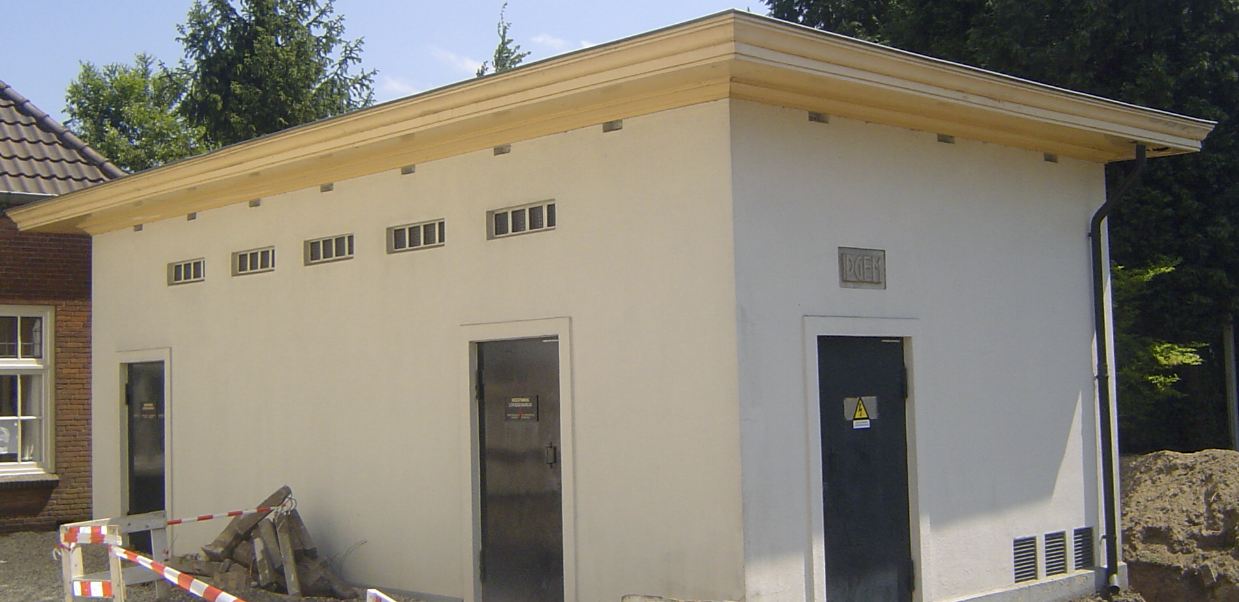Some benefits are only visible in the long term
30 November 2012 • John de Croon
asset management strategie, risk management, policy development, planning, program management, manage changes
Until a few years ago close to our house a beautiful transformer station was located. It had a reasonable size. It was quite a few years old and much attention was paid to the aesthetics, like was done with more transformer stations that were built in the same period. The building looked good (according to my opinion). The technology used was sound, because the electricity supply still functioned fine. For sure interim modifications were performed, but the old open low voltage installation was still there (and did not meet the current security requirements). The picture below, taken just before the demolition, gives an impression of the transformer station.

Next to the old transformer station is a beautiful, stately building from 1859 which previously had the functions of town hall and police station. The current owner of the building wanted the building to look better in its environment and in consultation with the grid operator it was decided to demolish the transformer station.
In terms of volume, it is 20x smaller than the previous version and stands between vegetation (see photo for the new one). I quite liked the old big transformer station, but some things evolve. The electricity is now probably more efficiently transformed than it was with the old transformer station (so better for the environment and less transformation losses thus lower operating costs), is it safer for inspectors and mechanics (no direct touchable parts) and cheaper to maintain (no painting).

Is it bad that the old unit is gone? That's just how you look at it. The criteria determine whether something is bad or not[1]. For the grid operator and owner of the former town hall, the new situation is certainly better than the old one. Indeed, otherwise they would not have replaced the old transformer station. Some benefits have been achieved immediately (the former town hall immediately looked better in its environment), other benefits come later (the transformer will be paid back later due to the higher efficiency so that the operating costs are lower, and thus the investment will (possibly) be recovered)[2].
The introduction of asset management is pretty much the same. Sometimes we help clients to implement short term measures. With a critical assessment of an existing investment and maintenance plan by means of a newly established business value framework, sometimes it is rapidly possible to get insight into how 20 to 30% can be saved without compromising the performance of other business values. Is that first step achieved, it is sometimes more difficult to make other improvements.
After the implementation of asset management related changes, employees at a company in question are not always happy with the new method which is introduced. Previously some employees could determine their own work, now these employees sometimes make part of the service provider. The asset manager now determines the work which should happen next, meaning a change for the employees who now work at the service provider. That's not always fun. Depending on the ambition, the introduction of a comprehensive asset management program is not always easy[3].
When the first asset management improvements are achieved, then to determine the financial benefits for the introduction of asset management can be difficult. Keep in mind that asset management systems last for at least 10 years. So it is an investment which may be of interest in the longer term, though it will initially not be directly obvious to all stakeholders. Also some stakeholders will have no direct benefit from another situation. That while some benefits will be immediately clear and present for other stakeholders.
The lack of aesthetics of the old transformer station will be accepted in the long term (you hear nobody about it anymore). Sometimes it takes a while before the benefits becomes visible (think of the energy saving). Also with asset management dare to occasionally make a change. Some benefits are not visible immediately and appear to be ‘overrun’ by disadvantages of the lack of a certain situation. But after a few years nobody knows better and you would not want to go back to the previous situation........ On the other hand, also consider certain stakeholders. Having a dialogue at an early stage can prevent a lot of resistance, so desired goals are reached earlier. Without dialogue these desired goals are even not achieved in many cases.....
[2] Unfortunately I don’t have data on the level of investment, reduced operational costs and thus payback time
John de Croon is partner at AssetResolutions BV, a company he co-founded with Ype Wijnia. In turn, they give their vision on an aspect of asset management in a weekly column. The columns are published on the website of AssetResolutions, http://www.assetresolutions.nl/en/column
<< back to overview
|


